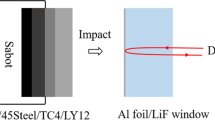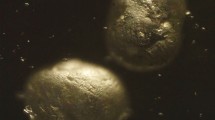Abstract
A simple device for producing cumulative shock loading in solids is described. The device uses a ballistic-impact-driven projectile to introduce high-stress waves into a solid. The impact time and load amplitude can be varied to produce fracture in one or several impacts in PMMA rods. The wavefront approached a square wave shape. Materials other than PMMA were loaded to failure to demonstrate the versatility of the device. Fracture morphologies observed with optical and scanning-electron microscopy are described.
Similar content being viewed by others
References
Roylance, D. K., “An EPR Investigation of Polymer Fracture,” PhD Dissertation, Department of Mechanical Engineering, University of Utah (August 1968).
Coleman, B. D., Gurtin, M. E., and Herrera, R., “Waves in Materials with Memory, I. The Velocity of One-Dimensional Shock and Acceleration Waves”,Arch. Rational Mech. Anal.,19, (1) (1964).
Kolsky, H., Stress Waves in Solids, Dover Publications, New York (1963).
Secor, G. A., Private communications.
Griffith, A. A., “The Phenomena of Rupture and Flow in Solids”Phil. Trans., Royal Soc., London, Series A 221,163 (1921).
Berry, J. P., “Fracture Processes in Polymeric Materials. I. The Surface Energy of Poly (Methyl Methacrylate)”,J. Polymer Sci.,50,107, (1961).
Rosen, B., Fracture Processes in Polymeric Solids, John Wiley and Sons, Inc., New York (1964).
Rosen, B., Fracture Processes in Polymeric Solids, John Wiley and Sons, Inc., New York (1968).
Berry, J. P., “Surface Characteristics of Franctured Poly (Methyl Methacrylate), Nature,185 91 (1960).
Zandman, F., “Etude de la deformation et de la Rupture des Matieres Plastiques,” Publications Scientific et Technique due Ministere de l'Air, (291) Paris (1954).
Kies, J. A., Newman, S. B., andWolock, I., in Fracture, Averbach, B. L., Fellback, D. K., Hahn, G. T., Thomas, D. A., Eds., John Wiley and Sons, Inc., New York (1959).
H. Schadin, “Untersuchung von Zerreissvorgangen bei Kunststoffen”,Kunstostoffe,44,48 (1954).
Broutman, L. J., andMcGarry, F. J., “Fracture Surface Work Measurements on Glassy Polymers by a Cleavage Technique, II. Effects of Crosslinking and Preorientation”,J. Appl. Polymers Sci.,9,609 (1969).
Berry, J. P., “Fracture Processes in Polkymeric Materials, IV. Dependence of the Fracture Surface Energy on Temepratures and Molecular Structure”,J. Polymer Sci., Part A,1,993 (1963).
Ziegler, E. E. andBrown, W. E., Plastics Technical Service Bulletin, Dow Chemical Company, Midland, Mich. (1954).
Kambour, R. P., “Optical Properties and Structure of Crazes in Transparent Glassy Polymers,”Nature,195,1299 (1962).
Kambour, R. P., “Refractive Indices and Compositions of Crazes in Several Glassy Polymers”,J. Polymer Sci., Part A,2,4159 (1964).
Doroles Labranche Simonson, 1970, MS Thesis, University of Utah.
Wulpi, D. J., How Components Fail, American Society for Metals, Metals Park, Ohio (1966).
Marsh, D. M., Flow and Fracture, in Glass in Frackture of Solids, Drucker, D. C., Ed., Interscience Publishers, New York (1963).
Bridgman, P. W., andSimon, I., “Effects of Very High Presures on Glass,”J. Appl. Phys. 24,405 (1953).
Author information
Authors and Affiliations
Additional information
This paper is based on a thesis submitted by Dolores Labranche Simonson, to the University of Utah, in partial fulfillment of the requirements of the MS. degree.
Rights and permissions
About this article
Cite this article
Simonson, D., Byrne, J.G. An exploratory investigation of cumulative shock fatigue. Experimental Mechanics 12, 201–208 (1972). https://doi.org/10.1007/BF02330274
Issue Date:
DOI: https://doi.org/10.1007/BF02330274




